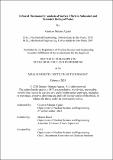| dc.contributor.advisor | Bucci, Matteo | |
| dc.contributor.author | Aguiar, Gustavo Matana | |
| dc.date.accessioned | 2024-04-30T20:29:41Z | |
| dc.date.available | 2024-04-30T20:29:41Z | |
| dc.date.issued | 2024-02 | |
| dc.date.submitted | 2024-03-11T16:12:07.581Z | |
| dc.identifier.uri | https://hdl.handle.net/1721.1/154320 | |
| dc.description.abstract | In this work, the dynamics of subcooled and saturated flow boiling are studied, focusing on the influence of surface characteristics, visualized through advanced diagnostics capturing micro-scale phenomena. Utilizing specially crafted thin-film infrared heaters, we measured bubble dynamics parameters and correlated them with surface properties. Nano-smooth and rough surfaces, comparable to nuclear reactor fuel claddings, were examined, and a nanoporous layer was applied to mimic fouling, enabling a detailed study of its effect on boiling heat transfer. A range of subcooled flow boiling tests were conducted, encompassing diverse mass velocities and degrees of subcooling. Through this, bubble dynamic parameters were measured across different surfaces, elucidating the effects of surface characteristics. The interplay between liquid heat transfer and bubble dynamics during subcooled flow boiling was another focal point of our investigation. In the saturated flow boiling tests carried out at a single mass velocity transitioning from a subcooled regime to annular flow, we analyzed the correlation between CHF and vapor quality across various surfaces. Specific attention was given to the CHF phenomena in slug flow, linking it to the flooding phenomena. In annular flow, the study pivoted towards understanding the transition of CHF mechanisms, from departure from nucleate boiling to dry out, and the consequential impact of disturbance waves. The findings of this study are instrumental in enhancing the accuracy of heat flux partitioning methods. The enriched understanding and insights are anticipated to be integral for developing more refined multiphase computational fluid dynamics codes, crucial for designing efficient heat-dissipating mechanisms in applications such as nuclear reactors. | |
| dc.publisher | Massachusetts Institute of Technology | |
| dc.rights | In Copyright - Educational Use Permitted | |
| dc.rights | Copyright retained by author(s) | |
| dc.rights.uri | https://rightsstatements.org/page/InC-EDU/1.0/ | |
| dc.title | Infrared Thermometry Analysis of Surface Effects in Subcooled and Saturated Boiling of Water | |
| dc.type | Thesis | |
| dc.description.degree | Ph.D. | |
| dc.contributor.department | Massachusetts Institute of Technology. Department of Nuclear Science and Engineering | |
| dc.identifier.orcid | https://orcid.org/0000-0001-6561-8264 | |
| mit.thesis.degree | Doctoral | |
| thesis.degree.name | Doctor of Philosophy | |
